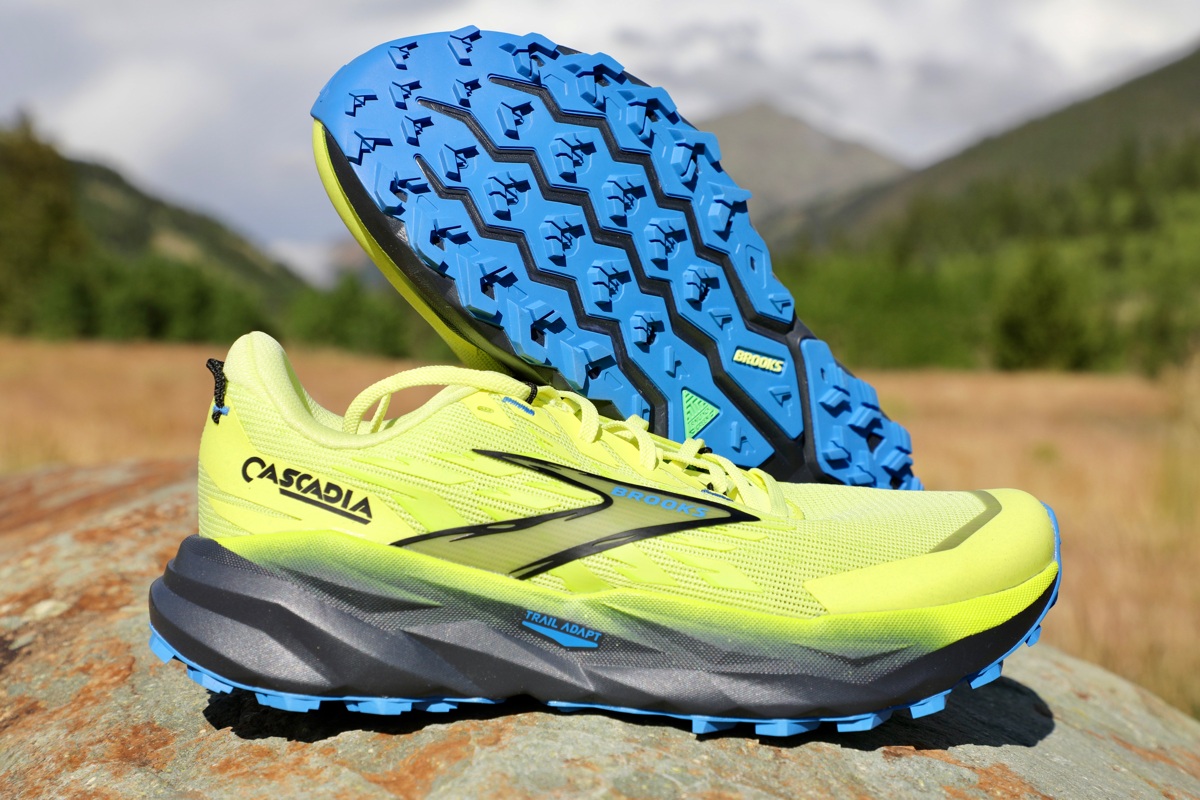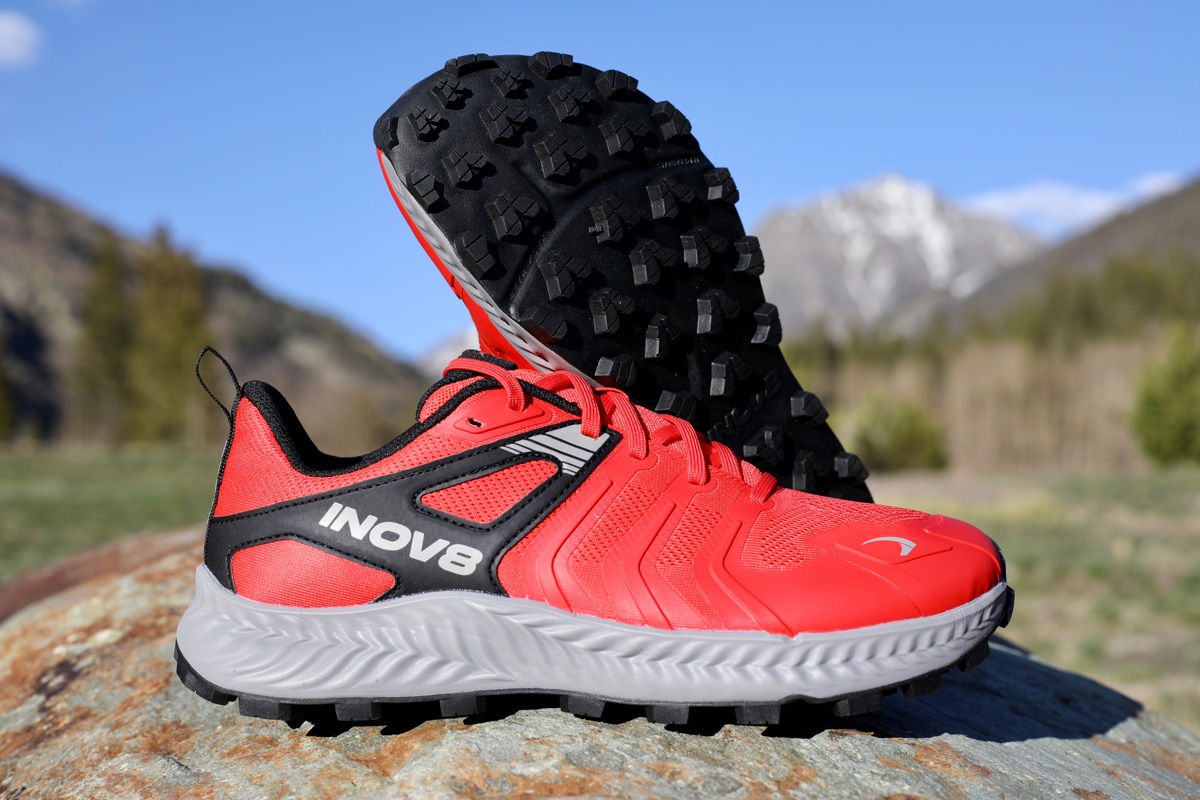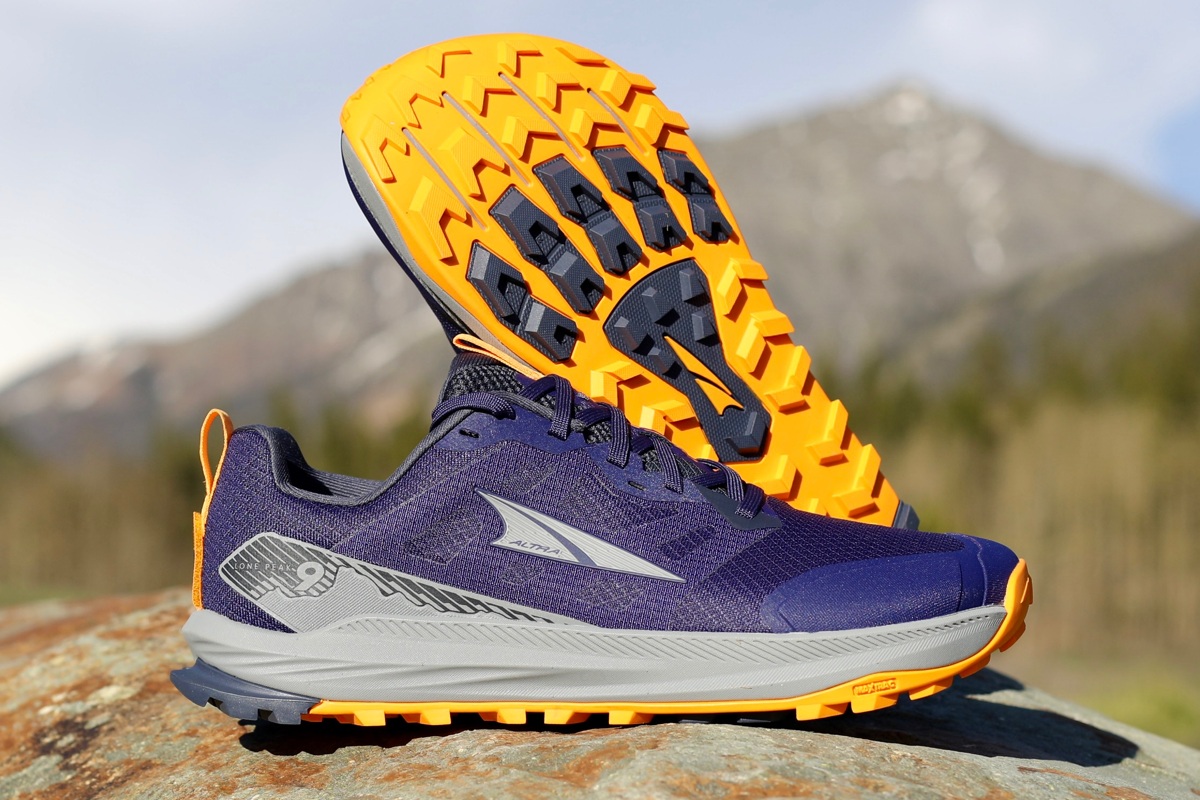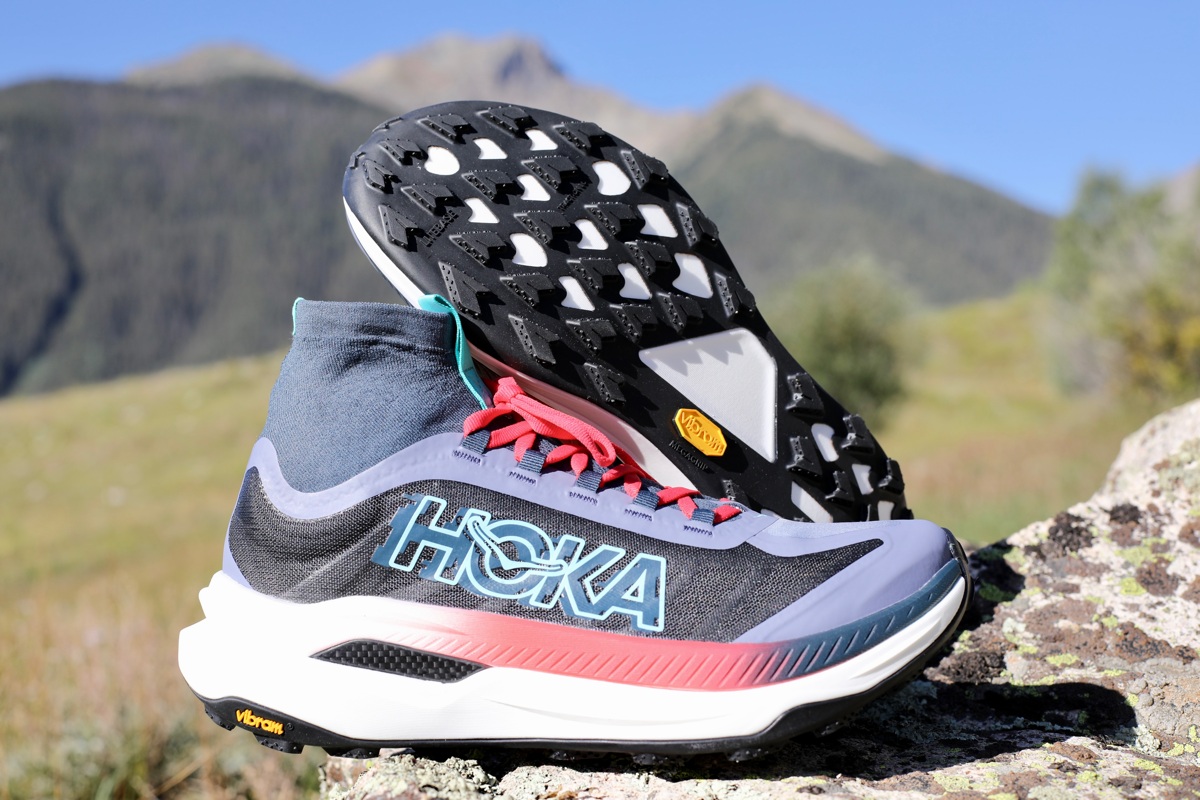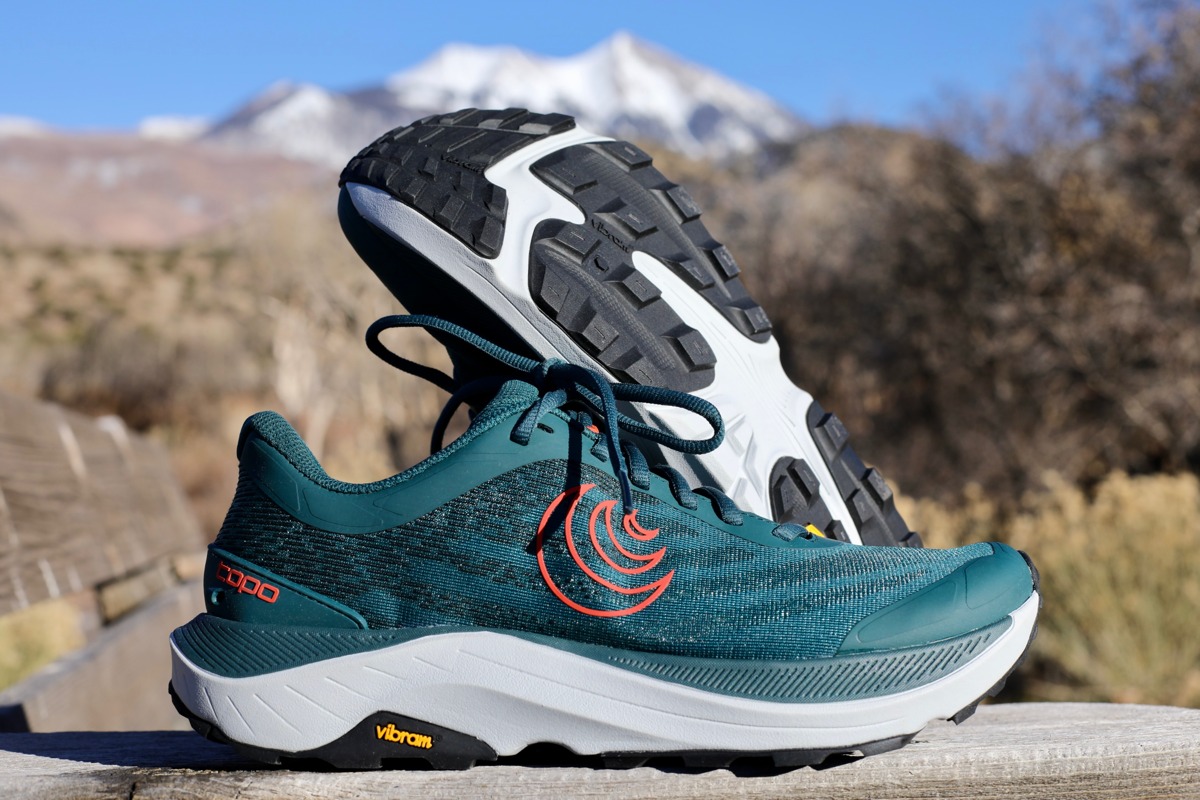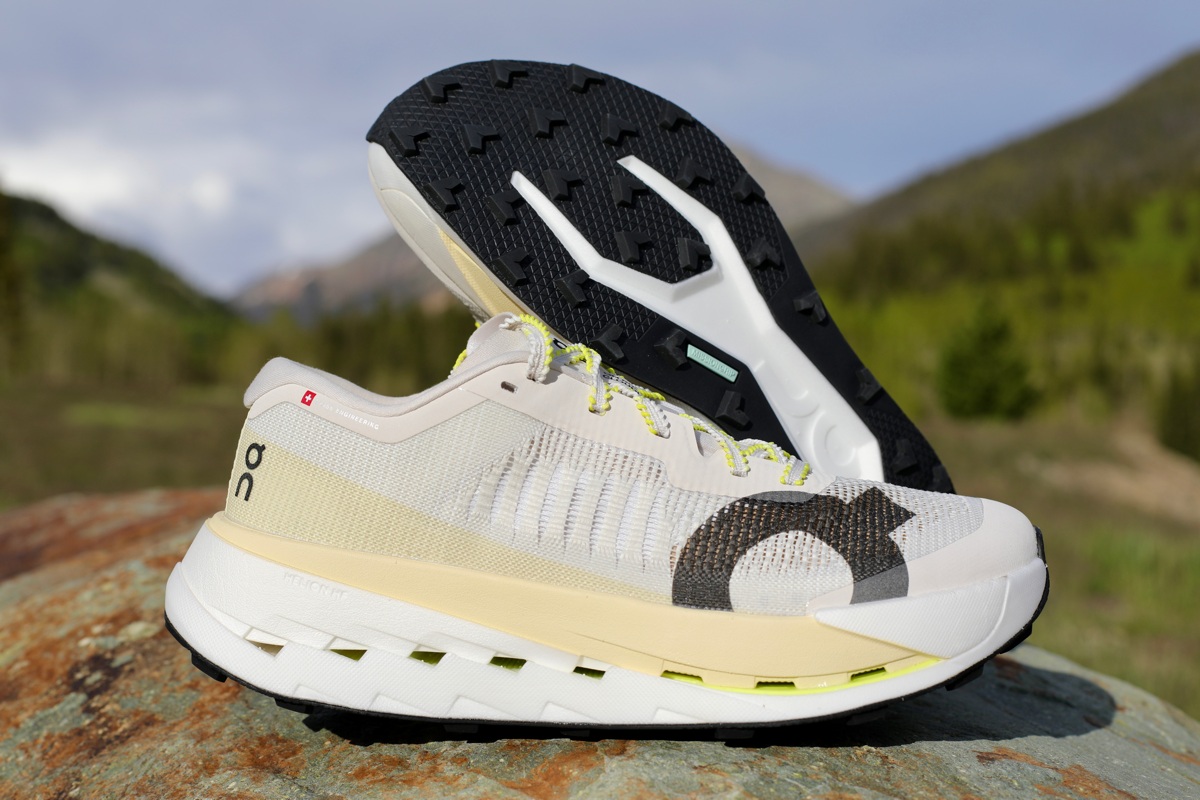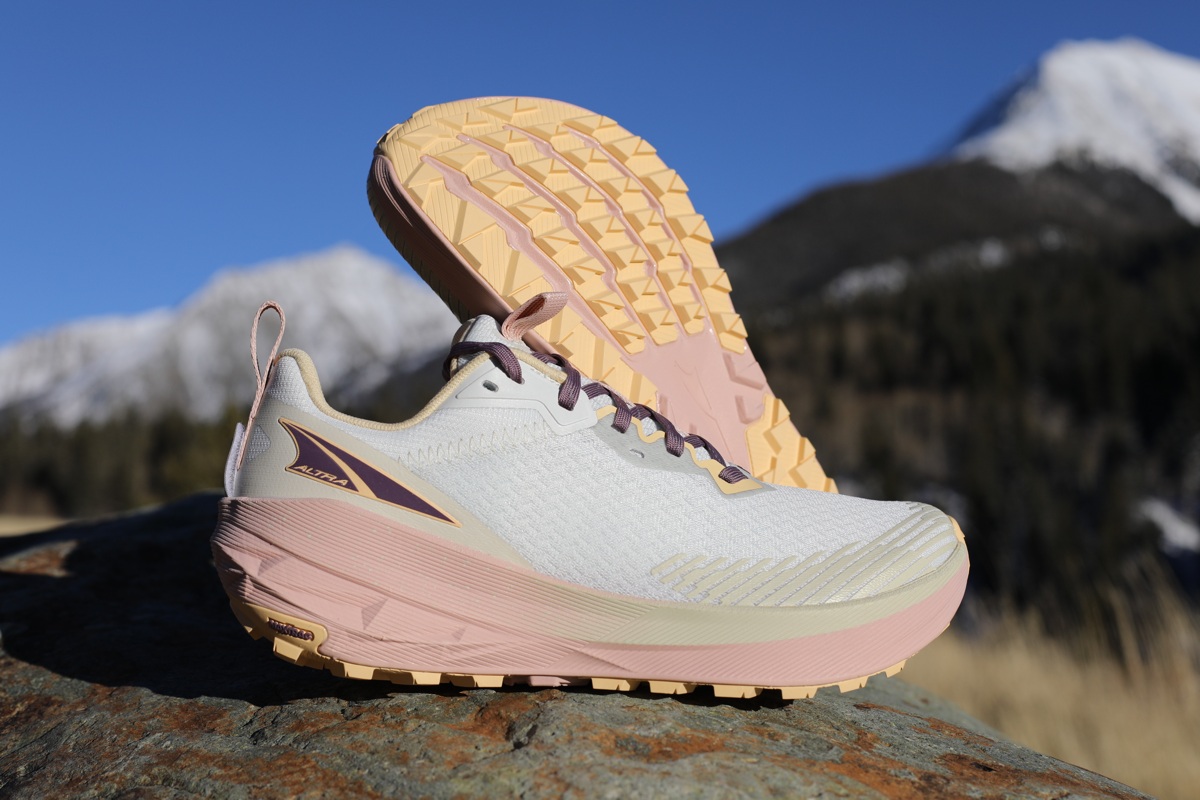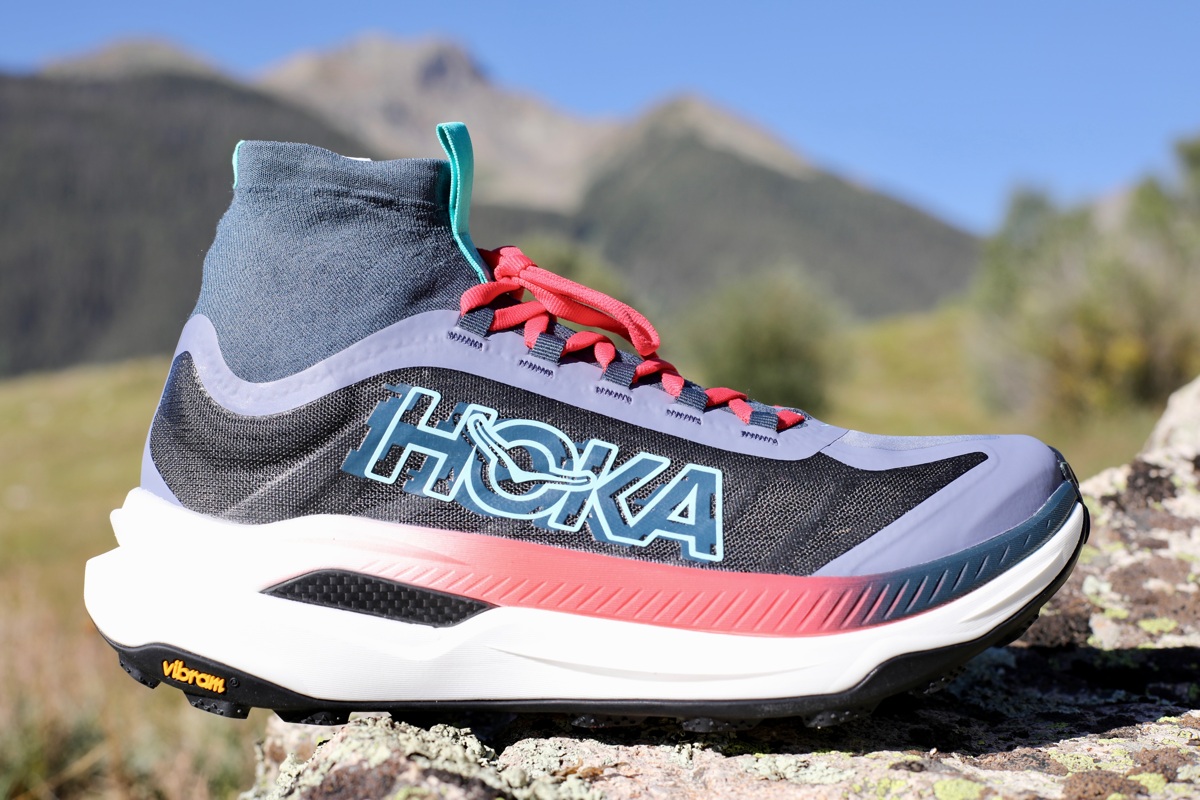
Editor-in-Chief Meghan Hicks testing trail running shoes above Silverton, Colorado. Photo: iRunFar/Bryon Powell
It is a glorious time to be a trail runner. With over 300 models on the market, there is a perfect shoe for every foot, terrain, and distance. The only downside is the overwhelming number of choices. Let us help you find the best pair for you.
For nearly 20 years, iRunFar has obsessively followed trail running footwear. Founder Bryon Powell compiled this guide with input from our 15-person test team, editorial staff, and the wider reader community.
Below, we’ve selected 13 top contenders to meet the needs of most runners. You can also jump to our buying advice or read about our testing methodology at the end of this article.
If you’re looking for additional options, we have more specific guides for:
- Cushioned trail running shoes,
- Lightweight trail running shoes,
- Trail running shoes for mud, and
- Road-to-trail shoes.
Best Trail Running Shoes
| SHOE (Click for review) |
SCORE | PRICE | BEST FOR | WEIGHT | DROP |
| Hoka Speedgoat 6 | 9.5 | $155 | Cushion | 9.9 oz | 5 mm |
| Hoka Tecton X 3 | 9.4 | $275 | 9.3 oz | 5 mm | |
| La Sportiva Prodigio Pro | 9.2 | $225 | 9.4 oz | 6 mm | |
| Brooks Cascadia 19 | 9.0 | $150 | All-Around | 10.7 oz | 6 mm |
| Altra Lone Peak 9 | 9.0 | $145 | Zero-Drop | 10.3 oz | 0 mm |
| La Sportiva Akasha II | 8.9 | $195 | 11.5 oz | 6 mm | |
| Saucony Peregrine 15 | 8.9 | $145 | 9.6 oz | 4 mm | |
| Inov8 TrailTalon | 8.8 | $150 | Mud | 9.7 oz | 6 mm |
| Salomon Speedcross 6 | 8.7 | $145 | 10.4 oz | 10 mm | |
| Nike Pegasus Trail 5 | 8.5 | $155 | Road-to-Trail | 10.2 oz | 9.5 mm |
| Altra Experience Wild 2 | 9.7 | $140 | 10.4 oz | 4 mm | |
| Topo Ultraventure 4 | 8.3 | $155 | 10.1 oz | 5 mm | |
| On Cloudultra Pro | 8.3 | $260 | 9.2 oz | 6 mm |
Best All-Around Trail Running Shoe: Brooks Cascadia 19 ($150)
Actual Weight (U.S. men’s 9): 10.7 ounces (303 grams) | Drop: 6 millimeters
Pros:
- An effective everyday road-to-trail shoe
- An increasingly agile option
Cons:
- A voluminous forefoot may make fit challenging for runners with narrow forefeet
The Brooks Cascadia is an oldie but a goodie. With a history dating back to the early 2000s, Brooks found a winning formula in the Cascadia that it has kept going for nearly two decades. If I had to recommend a pair of trail shoes to a new trail runner about whom I had no additional details, I’d point them toward the Brooks Cascadia 19.
Why? It’s a trail shoe that performs well on a variety of trail conditions while also still being a smooth ride on pavement as a road-to-trail shoe. Indeed, this latest iteration only makes the Cascadia an even more runnable shoe. In addition, the Cascadia’s moderate 6-millimeter heel-to-toe drop should make the shoe accessible for most runners.
The biggest changes with the Cascadia 19 are a reduction in drop from 8 to 6 millimeters and an upgrade to midsole foam, making the shoe feel even livelier. The shoes continue to provide the stable, moderately cushioned ride for which the Cascadia is known. In addition, the Ballistic Rock Shield offers plenty of protection on rocky terrain.
The Cascadia 19’s only shortcomings show up only in fringe-use cases, such as prolonged off-camber running, where the roomy forefoot can feel too roomy, and scenarios in which only extremely lugged shoes will provide traction.
Full Brooks Cascadia 19 review.
Shop the Men's Brooks Cascadia 19Shop the Women's Brooks Cascadia 19
Best Cushioned Trail Running Shoe: Hoka Speedgoat 6 ($155)
Actual Weight (U.S. men’s 9): 9.9 ounces (280 grams) | Drop: 5 millimeters
Pros:
- Generous cushion in a trail shoe that works
- Great traction
Cons:
- Just a bit too much shoe for some runners’ liking
The Hoka Speedgoat was a hit when it launched, and it has only improved over the years. With a breadth of well-cushioned trail shoes on the market these days, the Hoka Speedgoat 6 really is the standout of the group.
While it has plenty of cushioning, that cushioning isn’t so excessive as to get in the way for many trail runners. In fact, the biggest complaint many runners have about the Speedgoat 6 is that it’s a good deal firmer than the plush ride of its predecessor. Further underfoot, there are also generous lugs made from Vibram Megagrip, which yield strong traction in most conditions. That traction has only improved with the addition of Vibram’s Traction Lug, which provides a larger outsole surface area through textured lugs.
The most significant upgrade to the Speedgoat 6 is the model regaining structure to the upper that Hoka removed between versions 4 and 5. This greatly aids midfoot lockdown, increasing confidence on uneven terrain.
Overall, the Hoka Speedgoat 6 is a comfy shoe that can go the distance on any trail.
Full Hoka Speedgoat 6 review.
Shop the Men's Hoka Speedgoat 6Shop the Women's Hoka Speedgoat 6
Best Road-to-Trail Shoe: Nike Pegasus Trail 5 ($155)
Actual Weight (U.S. men’s 9): 10.2 ounces (290 grams) | Drop: 9.5 millimeters for U.S. men’s 10 and 8.5 millimeters for U.S. women’s 8
Pros:
- A dialed-in upper
- Responsive midsole foam
- Great insole
Cons:
- Not one’s first choice for loose scree, talus, or other highly technical terrain
The Nike Pegasus Trail 5 is an excellent option for those who spend long days on the trails or run on a mix of roads and trails. The Pegasus Trail’s strengths come from the ridiculously great React midsole foam, which one tester of a previous version that used the same foam said “felt alive.” The brand has many decades of designing top-notch footwear, so it’s no surprise the shoe is excellently constructed and plenty durable.
While the Pegasus Trail 5 tacked on a handful of grams from the Peg Trail 4, the shoe remains noticeably lighter than earlier versions. Part of those weight savings in the two most recent versions comes from a lightweight engineered mesh that excels in hot weather.
The Pegasus Trail 5 won’t be your top choice in sloppy trails or if you’re looking for a fast and light option for shorter trail races — although it’s improved in both these areas — but it’s an excellent choice for almost everything else. In fact, one tester noted the earlier Pegasus Trail 3 would be “the one shoe I’d take on vacation if I don’t know the conditions I’ll be running in,” and that holds just as true with today’s Pegasus Trail, if not more so.
Still, you might want to skip the Pegasus Trail on the rockiest and burliest of runs. It’s simply not designed to be the most protective of shoes, and better options exist for such outings.
The most notable upgrades to the Pegasus Trail 5 are better traction on fine debris, thanks to a redesigned outsole, and a more comfortable ankle collar, especially around the Achilles notch.
Full Nike Pegasus Trail 5 review.
Shop the Men's Nike Pegasus Trail 5Shop the Women's Nike Pegasus Trail 5
Best Trail Running Shoe for Mud: Inov8 TrailTalon ($150)
Actual Weight (U.S. men’s 9): 9.7 ounces (276 grams) | Drop: 6 millimeters
Pros:
- Excels in rain and mud
- Versatile outsole
- An anatomically precise fit, with the shoe available in standard or wide fits
Cons:
- Runs small
The Inov8 TrailTalon sits as the brand’s most versatile in its trail running range, evolving from its Roclite series. Compared to Inov8’s reputation for mud-devouring, uber-lugged shoes, and the more recent, lower-profile Trailfly, the TrailTalon’s multidirectional 6-millimeter lugs offer an ideal middle ground for everyday trail use, while being more than grippy enough for all but the most extreme conditions.
The upper offers a secure, pressure-free fit and withstands the elements well. Underfoot, the light and responsive Powerflow Pro cushioning creates a relatively low midsole heights of 18 millimeters at the heel and 12 millimeters at the toe, while the graphene-infused outsole rubber provides standout grip on wet and slippery terrain.
Within Inov8’s broader lineup, the TrailTalon emerges as a reliable do-everything workhorse. Against the wider market, it distinguishes itself with an anatomical fit, roomy toebox, confident traction, and inherently stable ride that results in a nimble, secure experience on wet, muddy, and uneven trails.
Read our full Inov8 TrailTalon review.
Shop the Men's Inov8 TrailTalonShop the Women's Inov8 TrailTalon
Best Zero-Drop Trail Running Shoe: Altra Lone Peak 9 ($145)
Actual Weight (U.S. men’s 9): 10.3 ounces (293 grams) | Drop: 0 millimeters
Pros:
- Incredibly roomy toebox while maintaining good lockdown
- Updates don’t break what works
Cons:
- A strong generalist shoe in a field of top-notch specialty shoes
The Altra Lone Peak 9 is so many things to so many people. For many trail runners, it’s their everyday trail shoe, from a short spin on the roads to an easy run in the local park to a 100-mile race across rugged terrain. For others, it’s an excellent daily wear (and occasional run) option for increasing lower leg strength and mobility outside of running. It’s no different among hikers, who’ve flocked to the Lone Peak line since its introduction.
So, what’s the secret to the Lone Peak’s success? A moderate amount of cushioning atop a grippy outsole with a marvelously roomy toebox.
The Lone Peak 9 perfectly continues the line’s comfortable upper, adequate cushioning, and generous toebox. The toe bumper has been beefed up again after a one-version reduction, resulting in safer toes and, along with other updates, a more durable shoe. Testers found it “ran lighter” than its weight.
Underfoot, the shoe is as cushioned as ever. The shoe continues to provide solid traction for most trail conditions. Overall, the Lone Peak 9 is a nimble, responsive, and yet remarkably comfortable ride with excellent ground feel.
Note that for some, Altra’s zero-drop platform is a significant advantage, while for others, it presents a challenge. If you’re new to low- or no-drop shoes, gradually build your mileage in Altras, letting any sore or tight calves or Achilles tendons recover between efforts.
Full Altra Lone Peak 9 review.
Shop the Men's Altra Lone Peak 9Shop the Women's Altra Lone Peak 9
Additional Outstanding Trail Running Shoes
With such extreme terrain diversity in trail running and the specific needs of our feet and bodies, there is no single best trail running shoe for everyone and every condition. However, in this section, we profile six generalist trail running shoe models that cover a broad range of conditions under which they excel.
Hoka Tecton X 3 ($275)
Actual Weight (U.S. men’s 9): 9.3 ounces (265 grams) | Drop: 5 millimeters
Pros:
- Lightweight and stable
- Great traction on a variety of trails
Cons:
- The built-in gaiter will alienate some
The Hoka Tecton X 3 is a lightweight, maximal ultra-distance racing shoe. Two layers of super-light PEBA in the midsole help keep the highly cushioned shoe from feeling clunky, while carbon plates support forward propulsion. In this newest version of the shoe, Hoka added winglets to the carbon plates to enhance lateral stability. Indeed, our tester found that the Tecton X 3 is among the most stable of the high-stack, lightweight, carbon-plated shoes she’s tried. Other, less obvious updates include a bit more room in the toebox, while maintaining a secure midfoot lockdown, and tweaks to the outsole lug design.
Now in its third iteration, the Tecton has seen some significant changes since its original launch. The most notable update in the current model is the addition of a knit gaiter. If you don’t love built-in gaiters, this might be a deterrent, if not a deal-breaker. However, if you’re open to — or even enticed by — the ankle gaiter, then you’ll find a lot to love about the latest Tecton.
The gaiter makes the shoe slightly annoying to put on, especially when it’s fresh out of the box. However, after initial skepticism, our tester begrudgingly appreciated the gaiter’s effectiveness at keeping trail debris out of her shoes, especially on Oregon’s South Sister, which typically requires a mid-descent break to dump volcanic scree out of the shoes. Thanks to the Tecton’s gaiter, no pause was needed.
Read our full Hoka Tecton X 3 review.
Shop the Men's Hoka Tecton X 3Shop the Women's Hoka Tecton X 3
La Sportiva Prodigio Pro ($225)
Actual Weight (U.S. men’s 9.5): 9.4 ounces (267 grams) | Drop: 6 millimeters
Pros:
- A lightweight and nimble feel that still offers substantial protection
- Between its sticky rubber, 4-millimeter lugs, and lug design, one of the best all-around outsole designs we’ve tested
Cons:
- Quite expensive for a non-plated shoe
- Some may find the upper unforgiving at longer ultra distances
The La Sportiva Prodigio Pro arrives as the high-performance racing sibling to the standard Prodigio, elevating the line with premium materials and a focus on speed. The shoe features a knitted upper with Power Wire that creates an incredibly secure, locked-down fit. Testers noted that the upper is durable and confidence-inspiring on technical ground. The fit runs small enough that sizing up a half size is highly recommended, and even then, not everyone finds the shoe accommodating for distances beyond 50k.
Underfoot is where the shoe truly distinguishes itself. It utilizes a dual-density midsole featuring a nitrogen-infused TPU core caged within EVA foam. This setup delivers a ride that is simultaneously light, soft, and responsive, absorbing rocks and roots without feeling squishy. A nylon rock plate adds barely there protection that shields the foot while maintaining the shoe’s flexible and springy character.
The outsole is composed of La Sportiva’s stickiest compound, FriXion white rubber, molded into 4-millimeter chevron lugs. This aggressive tread pattern digs effectively into loose surfaces and provides exceptional purchase on wet rocks. The shoe features a versatile 6-millimeter drop and a stack height (34 millimeters at the heel/28 millimeters at the toe) that feels cushioned enough for long distances, as evidenced by it being the second-most-worn shoe at the 2025 Hardrock 100.
Overall, the Prodigio Pro is a top-tier option for runners seeking a precise and agile shoe that can handle everything from a fast trail 10k to a rugged 50-mile trail run. While the $225 price tag and snug fit might give some pause, the combination of elite traction and a lively, protective midsole makes it a standout for technical mountain running.
Again, the Prodigio Pro runs small, so please do yourself a favor and go a half size up from your normal trail shoes unless you’re normally wearing trail shoes from La Sportiva or Norda.
Full La Sportiva Prodigio Pro review.
Shop the Men's La Sportiva Prodigio ProShop the Women's La Sportiva Prodigio Pro
Topo Ultraventure 4 ($155)
Actual Weight (U.S. men’s 9): 10.1 ounces (285 grams) | Drop: 5 millimeters
Pros:
- Gloriously accommodating toebox
- A highly versatile outsole
Cons:
- Fans of the Ultraventure 2 might miss its slightly lower height and greater ground feel
The Topo Ultraventure 4 is the latest evolution of Topo’s best-selling trail shoe. With ample cushioning and a bit higher stack of 35 millimeters at the heel and 30 millimeters in the forefoot than the brand’s typically lower-profile models, it’s built for runners seeking long-distance support and a plush underfoot feel.
While it retains much of what worked in its predecessor, the Ultraventure 4 features targeted upper updates to enhance durability in abrasion-prone areas. Topo’s ZipFoam adds a bit more energy to the midsole, and the broad, shallow multidirectional lugs provide reliable traction on mild to moderate trails while remaining versatile enough for mixed terrain and road.
With Topo’s signature roomy toebox, lightweight construction, and a trail-ready Vibram outsole, the Ultraventure 4 is well positioned to remain a crowd favorite.
Read our full Topo Ultraventure 4 review.
Shop the Men's Topo Ultraventure 4Shop the Women's Topo Ultraventure 4
On Cloudultra Pro ($260)
Actual Weight (U.S. men’s 9): 9.2 ounces (262 grams) | Drop: 6 millimeters
Pros:
- Comfortable, broken-in feel from day one
- Soft, protective cushioning with mild responsiveness
- Durable outsole and upper
Cons:
- Slightly narrow toebox may require sizing up
- Large mesh allows dust and water to enter easily
- Can feel unstable on fast, technical descents
- Very expensive for a non-carbon-plated shoe
The On Cloudultra Pro is a comfortable, highly cushioned trail shoe that works well for long runs and daily training on a wide range of terrain. The midsole is soft and protective without feeling disconnected from the ground, and the nylon plate adds a touch of responsiveness while keeping the ride more stable than a full carbon setup. The shoe feels broken in right out of the box and remains comfortable for hours at a time, especially on moderate trails and smoother singletrack.
The upper is breathable and drains well, which makes it a strong choice for warm-weather running. The tradeoff is that the large-pore mesh allows fine dust and water to enter easily, and it would likely struggle in cold or consistently wet conditions. Traction is reliable on everything from dry dirt and gravel to slick mud and wet surfaces, and durability has been solid with no issues in the outsole or upper. The shoe can feel a bit unstable on fast, technical descents due to the plated platform, and runners with wider feet may want to size up a half size for more room in the toebox.
Overall, the Cloudultra Pro is a versatile option for long runs, easy days, and efforts where comfort takes precedence over precision. It handles a mix of terrain well and offers a smooth, protective ride, though it’s less suited to highly technical routes or all-day wet conditions.
Full On Cloudultra Pro review coming soon.
Shop the Men's On Cloudultra ProShop the Women's On Cloudultra Pro
La Sportiva Akasha II ($195)
Actual Weight (U.S. men’s 9): 11.5 ounces (325 grams) | Drop: 6 millimeters
Pros:
- All-day comfort with plenty of protection
Cons:
- The heaviest shoe on this list
- Expensive
If you want a set-it-and-forget-it shoe, consider the La Sportiva Akasha II. It’s an all-day, all-mountain, all-the-miles shoe. Underfoot, the Akasha II uses the same midsole and outsole as its predecessor, providing plenty of traction and comfort and offering a ton of durability. While it’s the heaviest shoe on this list, it feels lighter on the foot than its weight would suggest.
On top of that platform sits a moderate-fit upper that successfully blends the midfoot lockdown that’s essential for navigating mountainous terrain with enough give and forgiveness to stay comfortable as long as you want to run. This second version of the Akasha includes minor tweaks to the upper to improve its breathability, durability, and protection simultaneously.
So, if you loved the original Akasha, be sure to try the Akasha II if you’re looking for a trail shoe you never have to think about!
Full La Sportiva Akasha II review.
Shop the Men's La Sportiva Akasha IIShop the Women's La Sportiva Akasha II
Altra Experience Wild 2 ($140)
Actual Weight (U.S. men’s 9): 9.7 ounces (274 grams) | Drop: 4 millimeters
Pros:
- The wide Altra toebox without zero-drop!
- All day comfort, stable
Cons:
- Slippery-as-shit outsole in wet conditions
- Really flexible upper without a lot of mid/forefoot support
Many zero-drop purists were flabbergasted when Altra released the predecessor to the Altra Experience Wild 2. The original version was the first non-zero-drop shoe from a brand built on zero-drop shoes. Purists aside, it was a welcome sight for those who appreciated the other notable characteristics of Altra shoes — notably the wide toebox — but who couldn’t run in zero-drop shoes regularly. The newest version adds a few new features from the original and has proven to be a comfortable everyday trail running shoe option.
This isn’t a shoe for extremes — whether on steep and technical trail or fast miles on pavement — but it’s a shoe that can do most things quite well. The mesh upper is flexible and soft, and while it’s not necessarily trustworthy on off-camber and steep terrain, it offers a reasonable level of lockdown that is more than enough for rolling terrain. The new version features more TPU overlays than the previous one, providing increased protection and stability. However, it remains a flexible upper that won’t effectively blunt the pain of a toe stub or keep the foot firmly in place for precise footwork. The toebox is classic Altra and provides plenty of space for the toes to spread out.
The most notable aspect of the EVA midsole is the amount of flare in the forefoot. While initially they may look a bit like clown shoes, the added platform does add stability, and the rocker is conducive to running. The 30-millimeter stack height at the heel and 26 millimeters at the forefoot provide enough cushion for comfort, but are low enough that the shoe doesn’t feel tippy, especially when paired with the flare. While the 4-millimeter drop of the Experience Wild 2 is still on the lower end of average, it’s enough to make the shoe more accessible to a wider variety of runners.
The outsole is made of the brand’s MaxTrac rubber and covers about 70% of the bottom of the shoe. The lugs — and outsole material — are arranged in strips that run from the front to the back of the shoe, with gaps in between. This ends up increasing the lateral flexibility of the shoe, and it bends easily over uneven terrain. A gap in the outsole coverage through the midfoot keeps the shoe from feeling stiff. Although the lower-profile lugs were plenty for most mixed-terrain runs, the shoes struggled on loose and steep terrain. On wet rocks, they failed to grip entirely.
For those who have been Altra-curious but afraid of zero-drop, these shoes may prove to be a good compromise.
Shop the Men's Altra Experience Wild 2Shop the Women's Altra Experience Wild 2
Saucony Peregrine 15 ($145)
Actual Weight (U.S. men’s 9): 9.6 ounces (273 grams) | Drop: 4 millimeters
Pros:
- It is a great all-around trail shoe at a reasonable price and light weight
- Good grip in a variety of conditions
Cons:
- No real standout feature or aspect
Over the past decade, the Saucony Peregrine has evolved from a trail racing shoe to something more akin to a classic, everyday trail shoe. Still, the Saucony Peregrine 15 has trended toward being slightly more speed worthy over recent generations, having dropped more than 1.5 ounces since the Peregrine 11. On the other hand, an updated midsole foam makes this version slightly more cushioned than its predecessor. The Peregrine 15’s outsole is capable in a wide variety of conditions, but it isn’t great on slick surfaces, such as wet rocks or bridges.
Overall, the Peregrine 15 won’t wow you with bells and whistles, but it has a great combination of traction, mild cushioning, sufficient underfoot protection, a breathable yet locked-down upper, and is reasonably lightweight. It just performs, and that’s awesome.
You can read our full Saucony Peregrine 15 review.
Shop the Men's Saucony Peregrine 15Shop the Women's Saucony Peregrine 15
Salomon Speedcross 6 ($145)
Actual Weight (U.S. men’s 9): 10.4 ounces (295 grams) | Drop: 10 millimeters
Pros:
- An outsole and upper combo that works great in sloppy conditions
- Improved fit
Cons:
- Can trap heat and moisture
If the Brooks Cascadia is impressive for its longevity, then the Salomon Speedcross line is equally impressive in standing the test of time. Why? Since launching in 2006, the Speedcross is only on its sixth major iteration in over 15 years! It remains a top-performing and top-selling product.
The Speedcross line is special because it combines a well-lugged outsole with a bombproof upper. No matter the terrain or the conditions, you can count on the Salomon Speedcross 6 to get you where you’re going.
The already amazing combination that is the Speedcross was again improved in the Speedcross 6, this time by making the shoe more comfortable. How? Well, Salomon simplified the toebox construction and improved the midsole.
Not only does the Salomon Speedcross 6 now stand up to longer runs, but it’s also still an incredibly durable shoe that’ll withstand many miles.
Full Salomon Speedcross 6 review.
Shop the Men's Salomon Speedcross 6Shop the Women's Salomon Speedcross 6
Guides to More Specialized Trail Running Shoes
While we included some cushioned trail shoes in this guide, we take a deeper dive into this category with our dedicated Best Cushioned Trail Running Shoes guide, which contains a larger set of maximally to moderately cushioned trail running shoes.
Most trail shoes should handle a moderate amount of mud, but for the muddiest of runs, you may want to consider dedicated shoes with enhanced traction. To find some great options, look no further than our Best Trail Running Shoes for Mud guide.
We’ve intentionally focused most of our picks above on a wide variety of generalist, everyday trail running shoes. But what if you’re looking for something speedier for a workout, race, or just for fun? Check out our dedicated Best Lightweight Trail Racing Shoes guide to see some fast and furious trail racing models.
And if many of your runs will see you switching from pavement to trail and back again, or you’ll be spending lots of time on dirt roads, take a look at our Best Road-to-Trail Shoes guide for some apropos picks!
Things to Consider When Choosing Trail Running Shoes
Benefits of Trail Running Shoes
First off, what are trail running shoes, and what are their benefits?
Trail running shoes provide several benefits over road running shoes when you head off-pavement — primarily increased traction, protection, and durability.
Trail shoes often offer more traction than road running shoes by having deeper, more widely spaced outsole lugs that penetrate in mud, snow, dust, and gravel to grip the ground. In addition, a trail shoe’s lugs are often made of a slightly softer and stickier rubber that is grippier on rocks but less durable on pavement.
The extra protection of trail shoes applies to both the top and bottom of the foot. Often, a trail shoe’s upper will have a thicker cap around the toes to offer some protection when you inevitably kick a rock or root. Burlier trail shoes can have more extensive reinforcements and overlays to protect the top of your foot.
Unlike road surfaces, the variability of trails can lead to rocks or roots poking through and irritating or injuring the bottom of your feet. Rock plates, found on many trail shoes, can provide push-through protection against sharp objects on the trail. Trail shoes with thick midsoles or very deep lugs might skip a rock plate if those components provide adequate separation between the trail and the sole of the foot.
When used for their intended purpose of running on trails, trail running shoes can be more durable than their road running cousins. This increased durability is primarily achieved through material choice and construction patterns in the upper. First, the choice of the primary material, whether it be mesh, a knit material, or something else, is often selected for its ability to withstand the conditions that trails throw at it. Second, fabric or thin-film overlays are applied over areas of the shoe’s upper that are more susceptible to wear, such as flex points in the front of the shoe or any area more likely to collect and self-abrade with dirt.
Separately, some trail shoe outsoles are constructed in a way that reduces the likelihood of detaching from the midsole, which is less of a consideration for road shoes.
Size and Fit
How should you choose the size of your trail running shoes? If you already own a pair of running shoes or other athletic shoes, you can start by trying the size that works for you with those, particularly if you’re sticking with the same brand.
In general, you’ll want roughly a thumb’s width between the end of your longest toe and the end of your shoe. Much less, and you could end up with blisters under your toenails as well as a greater chance of injuring a toe when you kick an obstacle.
If you have too much extra room, you’ll be more prone to sliding around in your shoe, which is unpleasant on uneven terrain, and you’ll be more likely to catch your toe on a rock or root.
Once you’ve got the length dialed in, ensure you can achieve a snug fit across the midfoot, from the front of the ankle to just behind your toes. This midfoot lockdown is important for keeping your foot firmly atop the outsole while making any lateral motions navigating the trail and when climbing and descending steep sections of trail.
Folks also have heels with varying volumes, so once your midfoot is locked down, you’ll want to see that your heel doesn’t move too much side to side or up and down relative to the shoe.
Finally, there’s the toebox, which is the forward cavity of a shoe where your toes go. Some people prefer generous toeboxes like those found in Altra and Topo shoes, such as the Altra Lone Peak 9, Altra Experience Wild 2, or Topo Ultraventure 4, while others prefer a more moderate toebox. Toeboxes tend to be narrower in trail shoes aimed at faster or more technical running.
Toebox size is a matter of personal feel and preference. Some shoes, particularly specialist shoes meant for shorter-distance racing, very technical terrain, or very steep conditions, may have a more precise fit in the toebox, but you still don’t want your toes smashed together.
If you’re aiming for ultra-distance efforts, you might choose a shoe that has at least moderate room for your toes to wiggle in the toebox, as well as a midfoot lockdown that’s less aggressive and more forgiving as your feet start to swell after hours on the trail.
Should you size up in trail running shoes? In most cases, you should not size up — at least in comparison to other athletic shoes. You want a trail shoe that locks your foot in place with a proper fit, and that’s not too long, such that you could more easily catch a toe on obstacles.
A decade ago, a person might have gone a half size up in trail running shoes, as some brands had only precise fits that were great when running fast on trails or navigating technical terrain, but were less forgiving in more relaxed trail running situations. Now, almost every brand offers trail shoes in various fits, so you can choose more accommodating models rather than moving up half a size. That said, we here at iRunFar are quick to note when specific models, like the La Sportiva Prodigio Pro, definitely warrant going up half a size, or whether someone on the edge of sizes might want to err on the high or low side.
Although it has become increasingly rare with the proliferation of trail shoes that offer more accommodating fits, occasionally an ultrarunner may pack a pair of trail shoes that are a half size up for events of half a day or longer to help cope with swelling feet, although such shoes are rarely used in practice.

Meghan Hicks testing trail running shoes in New Zealand’s scenic Matukituki Valley. Photo: iRunFar/Bryon Powell
Heel-to-Toe Drop
Heel-to-toe drop, or more simply, drop, refers to the difference in height from the heel to the toe of a shoe. Currently, heel-to-toe drop in trail shoes varies from 0 to 12 millimeters. Among runners, you might as well ask about religion, sex, or politics before asking for opinions on heel-to-toe drop. However, we firmly believe that the right answer is what works for you.
There’s an appealing argument that humans’ natural biomechanics are based on no heel-to-toe drop, as found in the Altra Lone Peak 9. This is an easier proposition for younger runners, those gradually easing into running, or those accustomed to no-drop or low-drop shoes, such as the Altra Experience Wild 2 at a 4-millimeter drop or the Saucony Peregrine 15 or Topo Ultraventure 4, both at a 5-millimeter drop.
Individuals with a longer history of running in traditional running shoes may want to stick to trail shoes with a higher 8- to 12-millimeter drop, such as the Nike Pegasus Trail 5 or Salomon Speedcross 6, or gradually transition down to lower-drop shoes if desired. These days, most trail shoes feature moderate drops of 6 to 8 millimeters, such as the Brooks Cascadia 19, Inov8 TrailTalon, or La Sportiva Prodigio Pro, which appear to work well for a wide range of runners.
It’s worth noting that the small but growing number of trail shoes with thick, highly rockered midsoles can lessen the traditional applicability of heel-to-toe drop numbers. Such models include the Hoka Speedgoat 6, Hoka Tecton X 3, and On Cloudultra Pro.
Lugs
Lugs refer to the protrusions of material on the bottom of a shoe’s outsole. While road running shoes often have minimal lugs, trail shoes generally have lugs that are 3 to 6 millimeters deep, like the Saucony Peregrine 15. Some trail shoes designed specifically for muddy conditions can have lugs as deep as 8 to 12 millimeters! Take a look at the Inov8 MudTalon Speed and our full guide to the best trail running shoes for mud, perfect for the luggiest of trail conditions.
Let’s zoom out to consider how deep our trail running shoe’s lugs should be.
This is a classic “it depends” question. Keep in mind that good technique can make running in mud more effective, and shoes with lugs that are 5 to 6 millimeters tall and more widely spaced can be great for wet, muddy, or otherwise sloppy conditions.
Most other trail shoes will have 3- to 5-millimeter lugs that are a bit more closely spaced and work in a great variety of conditions, such that unless you live in a notoriously wet environment, they are likely to work as your everyday trail shoe.
For extreme muddy conditions, there are a few trail shoes with widely spaced 7- to 8-millimeter lugs that are primarily suitable for steep climbing and descending in very wet and muddy terrain, and are likely a specialist addition to one’s quiver of trail shoes. There are even shoes for fell running in the U.K. with 12-millimeter lugs!
Midsole Cushioning
The midsole is the spongy component between the outsole and your foot. These days, midsoles are made from a wide variety of foams, ranging from minimal thickness to nearly 3 centimeters of material. For more midsole cushion, consider the Hoka Speedgoat 6, Hoka Tecton X 3, or On Cloudultra Pro. We’ve also got an entire guide dedicated to helping you find the best cushioned trail running shoes.
Rock Plate
A rock plate is a layer of deformation-resistant material, whether a plastic sheet, carbon plate, or other, that sits somewhere between a shoe’s outsole and the sock liner (aka, insole). The rock plate aims to prevent injury to the bottom of the foot as rocks or roots push through the shoe from below. Rock plates vary in length from the entire length of a shoe to the forefoot only.
Traditionally, rock plates were a staple feature of trail running shoes. Even today, a strong majority of trail running shoes have some sort of rock plate that runs from the forefoot through at least the midfoot, if not the entire length of the shoe.
With the rise of highly cushioned trail running shoes, brands have begun to eliminate rock plates from many of these models, as the shoes’ cushioning provides sufficient foot protection. On the other end of the spectrum, some racing-oriented models omit rock plates both for weight savings and to allow for a more natural ground feel.
Waterproof Shoes
Should I buy waterproof trail running shoes? In most cases, you shouldn’t buy waterproof trail running shoes for your trail runs. If it’s snowy or rainy, waterproof shoes can be more comfortable for walking down the street, shoveling the sidewalk, or doing yard work. On the other hand, there are pretty limited conditions where waterproof shoes will keep your feet dry when running.
Waterproof shoes may keep your feet dry if it’s not raining but there’s some moisture on the ground, such as dew or shallow puddles. Likewise, a waterproof shoe can keep your feet dry if you’re running when an inch or two of snow is on the ground.
If it’s actually raining, water will run down your leg, into the shoe through the ankle collar, and stay in your shoe with nowhere to drain. This same scenario would occur when running in anything more than a few inches of snow, unless you’re wearing running gaiters. Waterproof shoes are similarly futile if the temperature is much more than 50 degrees Fahrenheit outside, as foot sweat will collect in your shoes and lead to wet feet.
One side benefit of waterproof shoes is that they can add a bit of warmth if it’s cold or windy. However, after a couple of hours of running in cold and dry conditions, you may still end up with damp running socks due to foot sweat. Still, whether your feet are wet or dry, waterproof shoes can keep your feet a bit warmer.
If you feel the need for waterproof trail shoes, many of the most popular trail shoe models come in a waterproof version, including the Altra Lone Peak 9 Waterproof, Brooks Cascadia 19 GTX, Nike Pegasus Trail 5 Gore-Tex, and Salomon Speedcross 6 Gore-Tex.
Why You Should Trust Us
Led by iRunFar founder Bryon Powell, the team at iRunFar has tracked and tested the best trail running shoes available since 2008. Every year, our dedicated testers lace up more than 100 models of trail running shoes before logging tens of thousands of miles and millions of vertical feet across a wide range of geographies worldwide to compile the list of our top picks.
We consistently maintain a database of over 300 dedicated trail running shoes currently available on the market. We’ve created this guide using the iRunFar test team’s over 100 years of combined trail running shoe testing experience, additional insights from iRunFar’s other expert writers, extensive research, and the input of hundreds of iRunFar readers.
With the frequent release of new trail running shoes and even more frequent revision of existing models, this is a living document. We’re continually testing dozens of models of trail shoes. We update this guide as often as our expert team updates its thoughts on the best trail shoes available!

Byron Powell has been geeking out on trail shoes for a couple of decades! Photo: iRunFar/Meghan Hicks
